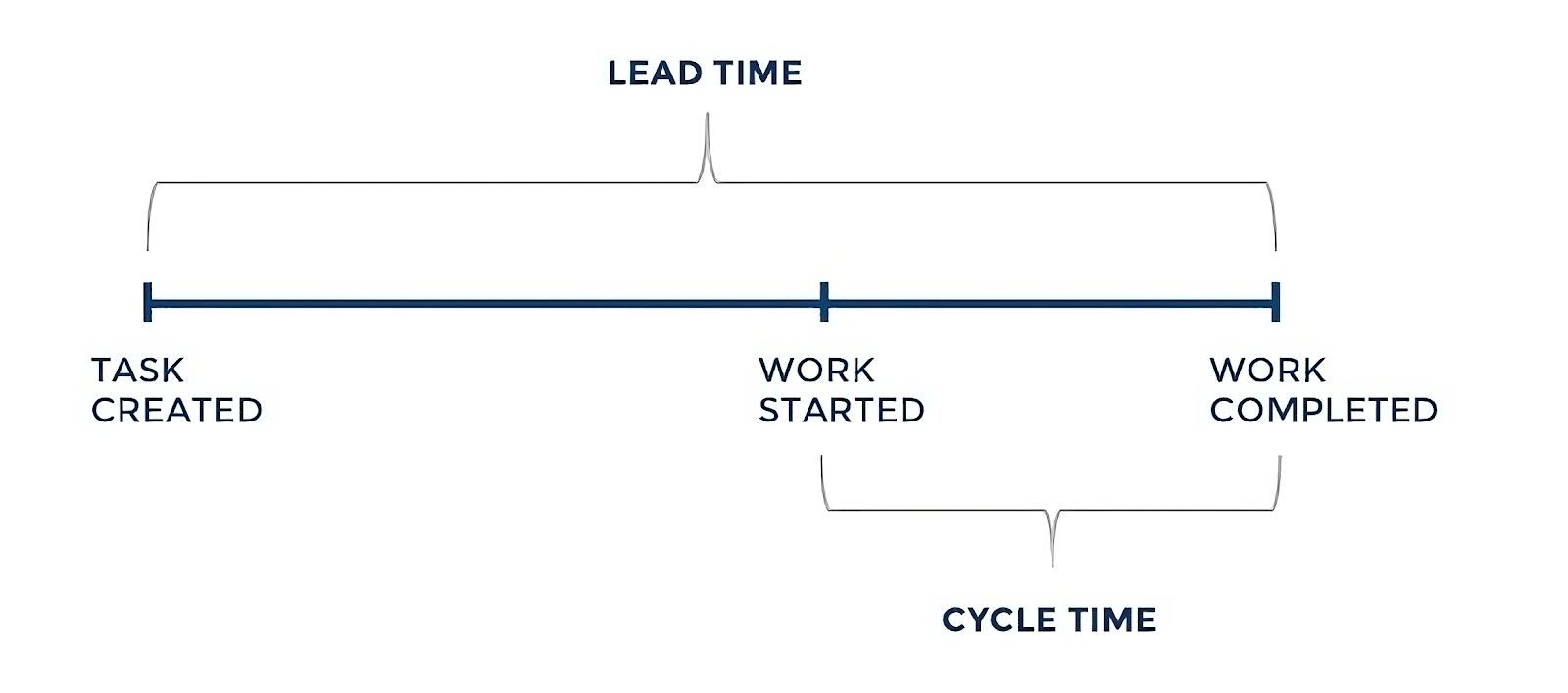In agile development, metrics are crucial for efficiency and productivity. Cycle time is a vital indicator of a team's effectiveness in delivering value to customers. In this post, we'll explain what it is, its calculation methods, and share some strategies.
What Is Cycle Time in Agile?
Cycle time in agile refers to the duration it takes for a work item to move through the entire development process. It encompasses all stages of development from initiation to completion, including planning, coding, testing, and deployment. Unlike lead time, which measures the total time a work item spends in the system, cycle time focuses solely on the active development phases.

Example of Cycle Time
Consider a software development team working on a new feature for an e-commerce platform. The cycle time begins when the team starts working on the feature and continues through coding and testing. It ends when the feature is deployed to production and made available to users. If the entire process takes ten days, the cycle time for that particular feature is ten days.
Understanding the Importance of Cycle Time in Agile Metrics
Cycle time is a fundamental metric in agile methodologies. It provides teams with valuable insights into their workflow efficiency and productivity. By measuring cycle time, teams can identify bottlenecks and streamline processes. Moreover, they can deliver value to customers more quickly. Additionally, cycle time serves as a key performance indicator (KPI). It enables teams to track their progress and make data-driven decisions for continuous improvement.
How Do You Calculate Cycle Time?
Calculating cycle time is a straightforward process that involves tracking the time it takes for individual work items to progress through the development pipeline. When teams calculate cycle time accurately, they can gain valuable insights into their workflow efficiency. In the process, they can identify areas for improvement.

1. Identify Start and End Points
The first step in calculating cycle time is to identify the start and end points of the work item's journey through the development process. The start point typically corresponds to when work on the item begins, such as, for example, when a task is pulled into the development queue or when coding begins. The endpoint marks the time when the work item is considered complete and ready for deployment, such as when the code is merged into the main branch and deployed to production.
2. Track Time
Once the start and end points are established, teams need to track the time it takes for the work item to move from start to finish. This can be done using time-tracking software, task boards, or manual recordkeeping. It's important to record the actual time spent on each stage of the development process accurately so that the calculation reflects the true cycle time.
3. Calculate Cycle Time
Once the time spent on each stage of the development process is recorded, calculating cycle time is a simple matter of subtracting the start time from the end time:
cycle time = end time - start time
The resulting value represents the total duration it took for the work item to progress through the development pipeline from initiation to completion.
For items that start and finish on the same day, you can modify the cycle time formula to the following:
cycle time = end date - start date + 1
Why add 1? Suppose you started a task on March 23 and completed it on the same day. According to the calculation, 23 - 23 = 0. However, it wouldn't make sense to claim that the task had a cycle time of zero days. Logically, the task took one day to complete, not zero days.
What Is a Good Cycle Time in Agile?
Determining what constitutes a good cycle time in agile depends on various factors such as the nature of the project, team size, and complexity of work items. However, a shorter cycle time is desirable. Generally, it signifies faster delivery and increased responsiveness to customer needs.
Ideal cycle times can vary across industries and organizations. For instance, in a highly competitive tech startup environment, where rapid iteration is paramount, a cycle time of a few days or even a few hours may be considered excellent. On the other hand, in industries with stringent regulatory requirements or complex processes, a longer cycle time may be unavoidable.
Agile teams must establish baseline cycle times based on historical data and continuously strive to reduce them through process improvements and automation.
How to Improve Cycle Time
Improving cycle time requires an approach that addresses inefficiencies at every stage of the development lifecycle. Here are some effective strategies you can implement to improve cycle time:

1. Improving DoR and DoD Metrics
The definition of ready (DoR) defines the criteria that must be met for a work item to enter the development pipeline. When teams ensure that requirements are clear, detailed, and prioritized, they can minimize rework and streamline the development process. Similarly, the definition of done (DoD) outlines the criteria for considering a work item complete. When teams maintain high DoD standards, they can deliver high-quality, production-ready features with minimal delays.
2. Leveraging Production-Like Remote Development Environments
Another effective way to improve cycle time is implementing production-like remote development environments. These environments closely mimic the production environment, allowing developers to test their code in a realistic setting before deployment. When teams identify and address issues early in the development process, they can prevent last-minute surprises and expedite the delivery of features.
3. Streamline Processes
Streamlining processes is essential for reducing cycle time and increasing efficiency. Agile teams should regularly review their workflows and identify areas where processes can be simplified or eliminated. When teams remove unnecessary steps and optimize handoffs between team members, they can minimize delays and accelerate the delivery of value to customers.
4. Implement Continuous Integration and Delivery (CI/CD)
Continuous integration and delivery (CI/CD) practices play a crucial role in reducing cycle time and enhancing the quality of deliverables. When teams automate the build, test, and deployment processes, they can accelerate the delivery of features and minimize errors.
CI/CD pipelines enable teams to automatically build, test, and deploy code changes whenever new code is committed to the repository. This automation reduces manual intervention, streamlines the development process, and ensures that features are delivered to customers more quickly and reliably. Additionally, CI/CD practices facilitate rapid feedback loops, allowing teams to detect and address issues early in the development cycle.
In summary, when teams continuously integrate code changes and deliver them to production in small, incremental steps, they can mitigate risks and improve overall productivity.
5. Leverage Agile Metrics to Drive Continuous Improvement
In addition to cycle time, agile teams can utilize a variety of metrics such as lead time, throughput, and burn-down rates to gain insights into their performance and identify areas for enhancement. Regularly monitoring these metrics and visualizing them on agile dashboards promotes transparency, accountability, and continuous improvement. By fostering a culture of data-driven decision-making, teams can adapt quickly to changing circumstances and optimize their delivery processes effectively.
Incorporating these strategies empowers agile teams to continuously optimize their cycle times, fostering greater efficiency, flexibility, and customer satisfaction. By embracing agile principles and practices, organizations can accelerate their time to market, enhance product quality, and stay ahead of the competition in today's fast-paced business environment.
Conclusion
Cycle time serves as a vital performance metric in agile development, reflecting a team's ability to deliver value quickly and consistently. By understanding its definition, calculation methods, significance, and strategies for improvement, agile practitioners can leverage cycle time effectively to drive continuous improvement and achieve operational excellence.
Embracing agile principles and practices enables teams to adapt to changing requirements, deliver value iteratively, and thrive in today's fast-paced business environment. With a focus on streamlining processes, embracing automation, and fostering a culture of continuous improvement, organizations can enhance their agile capabilities and stay competitive in the digital age.
This post was written by Bravin Wasike. Bravin holds an undergraduate degree in Software Engineering. He is currently a freelance Machine Learning and DevOps engineer. He is passionate about machine learning and deploying models to production using Docker and Kubernetes. He spends most of his time doing research and learning new skills in order to solve different problems.








